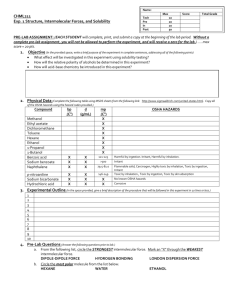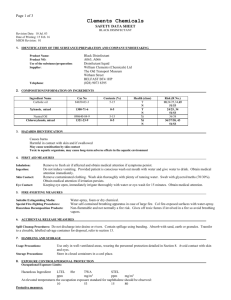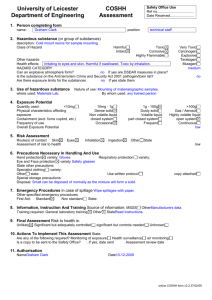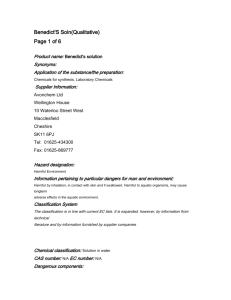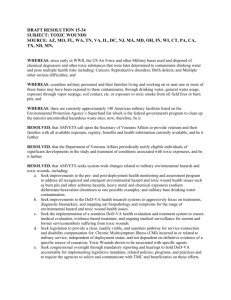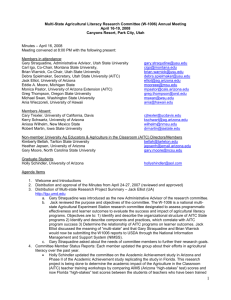AITC (IR9804) (rev 2) (CLP) (Eng).RTF
advertisement
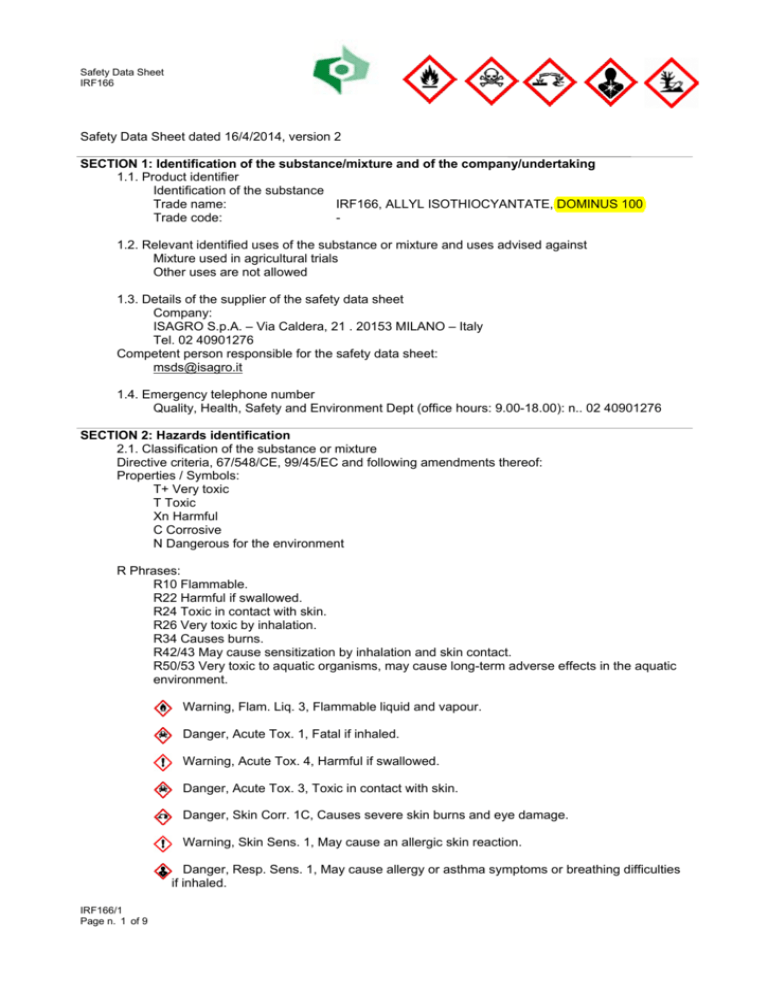
Safety Data Sheet
IRF166
Safety Data Sheet dated 16/4/2014, version 2
SECTION 1: Identification of the substance/mixture and of the company/undertaking
1.1. Product identifier
Identification of the substance
Trade name:
IRF166, ALLYL ISOTHIOCYANTATE, DOMINUS 100
Trade code:
1.2. Relevant identified uses of the substance or mixture and uses advised against
Mixture used in agricultural trials
Other uses are not allowed
1.3. Details of the supplier of the safety data sheet
Company:
ISAGRO S.p.A. – Via Caldera, 21 . 20153 MILANO – Italy
Tel. 02 40901276
Competent person responsible for the safety data sheet:
msds@isagro.it
1.4. Emergency telephone number
Quality, Health, Safety and Environment Dept (office hours: 9.00-18.00): n.. 02 40901276
SECTION 2: Hazards identification
2.1. Classification of the substance or mixture
Directive criteria, 67/548/CE, 99/45/EC and following amendments thereof:
Properties / Symbols:
T+ Very toxic
T Toxic
Xn Harmful
C Corrosive
N Dangerous for the environment
R Phrases:
R10 Flammable.
R22 Harmful if swallowed.
R24 Toxic in contact with skin.
R26 Very toxic by inhalation.
R34 Causes burns.
R42/43 May cause sensitization by inhalation and skin contact.
R50/53 Very toxic to aquatic organisms, may cause long-term adverse effects in the aquatic
environment.
Warning, Flam. Liq. 3, Flammable liquid and vapour.
Danger, Acute Tox. 1, Fatal if inhaled.
Warning, Acute Tox. 4, Harmful if swallowed.
Danger, Acute Tox. 3, Toxic in contact with skin.
Danger, Skin Corr. 1C, Causes severe skin burns and eye damage.
Warning, Skin Sens. 1, May cause an allergic skin reaction.
Danger, Resp. Sens. 1, May cause allergy or asthma symptoms or breathing difficulties
if inhaled.
IRF166/1
Page n. 1 of 9
Safety Data Sheet
IRF166
Warning, Aquatic Chronic 1, Very toxic to aquatic life with long lasting effects.
Adverse physicochemical, human health and environmental effects:
No other hazards
2.2. Label elements
Symbols:
Danger
Hazard statements:
H226 Flammable liquid and vapour.
H330 Fatal if inhaled.
H302 Harmful if swallowed.
H311 Toxic in contact with skin.
H314 Causes severe skin burns and eye damage.
H317 May cause an allergic skin reaction.
H334 May cause allergy or asthma symptoms or breathing difficulties if inhaled.
H410 Very toxic to aquatic life with long lasting effects.
Precautionary statements:
P210 Keep away from heat/sparks/open flames/hot surfaces. — No smoking.
P280 Wear protective gloves/protective clothing/eye protection/face protection.
P303+P361+P353 IF ON SKIN (or hair): Remove/Take off immediately all contaminated
clothing. Rinse skin with water/shower.
P304+P340 IF INHALED: Remove victim to fresh air and keep at rest in a position
comfortable for breathing.
P305+P351+P338 IF IN EYES: Rinse cautiously with water for several minutes. Remove
contact lenses, if present and easy to do. Continue rinsing.
P310 Immediately call a POISON CENTER or doctor/physician.
P370+P378 In case of fire: Use chemical foam/powder or carbon dioxide for extinction.
P403+P233 Store in a well-ventilated place. Keep container tightly closed.
Special Provisions:
None
2.3. Other hazards
It does not contain vPvB/PBT substances.
Other Hazards:
Vesicant, lachrymator
If heated to decomposition or on contact with acid or acid fumes, it emits highly toxic fumes;
can react with oxidizing materials.
Risk of causing a spontaneous violent reaction (see Kemler number in section 14).
SECTION 3: Composition/information on ingredients
3.1. Substances
Not applicable
3.2. Mixtures
Hazardous components within the meaning of EEC directive 67/548 and CLP regulation and
related classification:
IRF166/1
Page n. 2 of 9
Safety Data Sheet
IRF166
99.8% Allyl Isothiocyanate (AITC)
CAS: 57-06-7, EC: 200-309-2
T+,T,Xn,C,N; R42/43-10-26-24-22-34-50/53
2.6/3 Flam. Liq. 3 H226
3.1/1/Inhal Acute Tox. 1 H330
3.1/4/Oral Acute Tox. 4 H302
3.1/3/Dermal Acute Tox. 3 H311
3.2/1C Skin Corr. 1C H314
3.4.2/1 Skin Sens. 1 H317
3.4.1/1 Resp. Sens. 1 H334
4.1/C1 Aquatic Chronic 1 H410
SECTION 4: First aid measures
4.1. Description of first aid measures
In case of skin contact:
Immediately take off all contaminated clothing.
Areas of the body that have - or are only even suspected of having - come into contact with
the product must be rinsed immediately with plenty of running water and possibly with soap.
WARNING! This product is toxic through skin contact. OBTAIN IMMEDIATE MEDICAL
ATTENTION.
Wash thoroughly the body (shower or bath).
Remove contaminated clothing immediatley and dispose off safely.
In case of eyes contact:
After contact with the eyes, rinse with water with the eyelids open for a sufficient length of
time, then consult an opthalmologist immediately.
Protect uninjured eye.
In case of Ingestion:
Do NOT induce vomiting.
Give nothing to eat or drink.
In case of Inhalation:
If breathing is irregular or stopped, administer artificial respiration.
In case of inhalation, consult a doctor immediately and show him packing or label.
After contact with skin, wash immediately with soap and plenty of water.
4.2. Most important symptoms and effects, both acute and delayed
May cause allergy or asthma symptoms or breathing difficulties if inhaled.
May cause an allergic skin reaction.
At high doses the substance is toxic to kidney, stomach and urinary bladder.
Very dangerous if swallowed, in contact with skin/eyes and if inhalated (see also R phrases/H
statements in section 2).
Dangerous if in contact with skin and eye (corrosive, it facilitates permeation).
4.3. Indication of any immediate medical attention and special treatment needed
In case of accident or unwellness, seek medical advice immediately (show directions for use
or safety data sheet if possible).
Treatment:
Treat symptomatically and supportively.
SECTION 5: Firefighting measures
5.1. Extinguishing media
Suitable extinguishing media:
CO2, chemical foam or dry chemical fire extinguisher.
IRF166/1
Page n. 3 of 9
Safety Data Sheet
IRF166
Extinguishing media which must not be used for safety reasons:
None in particular.
5.2. Special hazards arising from the substance or mixture
Do not inhale explosion and combustion gases which, at high temperatures, may produce
toxic substances such as COx, NOx, CS2, HCN, COS.
Burning produces heavy smoke.
5.3. Advice for firefighters
Use suitable breathing apparatus .
Collect contaminated fire extinguishing water separately. This must not be discharged into
drains.
Move undamaged containers from immediate hazard area if it can be done safely.
SECTION 6: Accidental release measures
6.1. Personal precautions, protective equipment and emergency procedures
Wear personal protection equipment.
Remove all sources of ignition.
Wear breathing apparatus if exposed to vapours/dusts/aerosols.
Provide adequate ventilation.
Use appropriate respiratory protection.
See protective measures under point 7 and 8.
6.2. Environmental precautions
Do not allow to enter into soil/subsoil. Do not allow to enter into surface water or drains.
Retain contaminated washing water and dispose it.
In case of gas escape or of entry into waterways, soil or drains, inform the responsible
authorities.
Suitable material for taking up: absorbing material, organic, sand
6.3. Methods and material for containment and cleaning up
Wash with plenty of water.
6.4. Reference to other sections
See also section 8 and 13
SECTION 7: Handling and storage
7.1. Precautions for safe handling
Avoid contact with skin and eyes, inhaltion of vapours and mists.
Use localized ventilation system.
Don't use empty container before they have been cleaned.
Before making transfer operations, assure that there aren't any incompatible material
residuals in the containers.
Contamined clothing should be changed before entering eating areas.
Do not eat or drink while working.
See also section 8 for recomened protective equipment.
7.2. Conditions for safe storage, including any incompatibilities
Keep away from unguarded flame, sparks, and heat sources. Avoid direct exposure to
sunlight. Store in a darkened place, cool (T < 20 °C) and dry.
Keep away from food, drink and feed.
Incompatible materials:
Strong oxidants and reducing agents, strong acids and bases, water, alcohol and amines.
See also section 10.
Instructions as regards storage premises:
If possible store in the dark and in any case protected by direct sun light. Store in a cool and
adequately ventilated place.
7.3. Specific end use(s)
None in particular.
SECTION 8: Exposure controls/personal protection
8.1. Control parameters
No occupational exposure limit available
8.2. Exposure controls
IRF166/1
Page n. 4 of 9
Safety Data Sheet
IRF166
Eye protection:
Not needed for normal use. Anyway, operate according good working practices.
Protection for skin:
Use clothing that provides comprehensive protection to the skin, e.g. PVC, PTFE (poly
tetrafluoro ethylene) or fluorinated rubber.
Protection for hands:
Use protective gloves that provides comprehensive protection, e.g. PVC, PTFE (poly
tetrafluoro ethylene), fluorinated rubber or butilic rubber.
Respiratory protection:
Based on the conditions of use and where ventilation is not sufficient and/or for a long
exposure, provide respiratory protection.
If needed use air purifying respirator with an organic-vapor removing cartridge (ABEK filter).
Thermal Hazards:
None
Environmental exposure controls:
None
SECTION 9: Physical and chemical properties
9.1. Information on basic physical and chemical properties
Appearance and colour:
Liquid
Odour:
Pungent
Odour threshold:
Non available
pH:
4-5 (1% suspension in water)
Melting point / freezing point: - 80 °C (referred to AITC)
Initial boiling point and
boiling range:
151 °C (referred to AITC)
Solid/gas flammability:
Upper/lower flammability
Not available
or explosive limits:
Not available
Vapour density:
3,4 (air = 1) (referred to AITC)
Flash point:
46 °C (closed cup) (referred to AITC)
Evaporation rate:
Vapour pressure:
1.33 kPa at 38.3 °C (referred to AITC)
Relative density:
1.013 kg/l (referred to AITC)
Solubility in water:
2 g/L at 20 °C (referred to AITC)
Solubility in oil:
Soluble in most common organic solvents
Partition coefficient
n-octanol/water):
Log P = 2.11 (referred to AITC)
Auto-ignition temperature:
Not available
Decomposition temperature:
Not determined
Viscosity:
Not determined
Explosive properties:
Not classified as explosive
Oxidizing properties:
Not oxidizing
9.2. Other information
Miscibility:
Fat Solubility:
Conductivity:
Substance Groups relevant
Properties
Not available
Not available
Not available
It can cause a spontaneous violent reaction
SECTION 10: Stability and reactivity
10.1. Reactivity
Stable under normal conditions
10.2. Chemical stability
Stable under normal conditions and if stored in original packaging (stabilized with inert gas).
10.3. Possibility of hazardous reactions
IRF166/1
Page n. 5 of 9
Safety Data Sheet
IRF166
It may generate toxic gases on contact with strong oxidising agents, and strong reducing
agents.
It may catch fire on contact with strong oxidising agents.
It may react vigorously with water at temperatures > 100 °C
It may react spontaneosly with violence
It may emit toxic fumes when on contact with strong oxidizing agents, strong reducing agents.
10.4. Conditions to avoid
Stable under normal conditions. Avoid T > 40 °C and keep away from ignition sources.
10.5. Incompatible materials
Avoid strong oxidizing/reducing substances, strong acids and bases, water, alcohols and
amines.
Avoid contact with oxidizing materials, with acids and acid fumes. The product could catch
fire.
10.6. Hazardous decomposition products
It doesn’t give decomposition in normal storage conditions and in original containers
(stabilized product with inert gas).
At high temperatures it decomposes giving dimers, trimers and cyclization products.
SECTION 11: Toxicological information
11.1. Information on toxicological effects
Data referred to AITC:
Acute toxicity:
LD50 (oral):
425 mg/kg (rat, female) (internal study) (ref. method OPPTS 870.1100)
LC50 (4h) (dermal):
Between 200 mg/kg and 2000 mg/kg (rat, male and female) (method OPPTS
870.1200)
LC50 (4h) (inhalation):
Between 0.206 mg/L and 0.508 mg/L (rat, 4h) (internal study) (method OPPTS
870.1300)
Irritating power/Corrosivity:
It may cause severe skin burns and severe eye damage (rabbit, female) (H314)
(internal study) (method OPPTS 870.2500)
Sensitization:
It may cause an allergic skin raction (H317) (mice, female) (internal study) (method
OPPTS 870.2600)
It may cause allergy or asthma symptoms or breathing difficulties if inhaled (H334)
(internal study) (method OPPTS 870.2600)
Subchronic toxicity:
The substance is toxic on kidney, stomach and urinary bladder.
Carcinogenic/teratogenic/mutagenic effects:
No carcinogenic/teratogenic/mutagenic effect
SECTION 12: Ecological information
12.1. Toxicity
Adopt good working practices, so that the product is not released into the environment.
Very toxic to aquatic organisms, may cause long-term adverse effects in the aquatic
environment.
IRF166/1
Page n. 6 of 9
Safety Data Sheet
IRF166
Data referred to AITC:
FishLC50 (96h): < 0.1 mg/L (bibliographic source)
12.2. Persistence and degradability
Data referred to AITC:
Degradability (soil): t1/2=20-60 hours
12.3. Bioaccumulative potential
Not available
12.4. Mobility in soil
Not available
12.5. Results of PBT and vPvB assessment
Not requested
12.6. Other adverse effects
None
SECTION 13: Disposal considerations
13.1. Waste treatment methods
Recover, if possible. Send to authorised disposal plants or for incineration under controlled
conditions. In so doing, comply with the local and national regulations currently in force.
SECTION 14: Transport information
14.1. UN number
ADR-UN number:
IATA-Un number:
IMDG-Un number:
14.2. UN proper shipping name
ADR-Shipping Name:
IMDG-Technical name:
1545
1545
1545
ALLYL ISOTHIOCYANATE, STABILIZED solution
ALLYL ISOTHIOCYANATE, STABILIZED solution
14.3. Transport hazard class(es)
ADR-Class:
ADR-Label:
ADR –
Hazard identification number:
IATA-Class:
IMDG-Class:
IMDG-Label:
639
6.1
6.1
6.1 + 3 + Marine Pollutant
14.4. Packing group
ADR-Packing Group:
IMDG-Packing group:
II
II
14.5. Environmental hazards
Marine pollutant:
Marine pollutant
14.6. Special precautions for user
Kemler Code:
Limited Quantity:
IMDG-EMS:
Tunnel restriction code:
IRF166/1
Page n. 7 of 9
6.1
6.1 + 3 + Marine Pollutant
639
Toxic and flammable material (flash point ≤ 60 °C), which
may cause a spontaneous violent reaction
100 mL
F-E, S-D
(D/E)
Safety Data Sheet
IRF166
14.7. Transport in bulk according to Annex II of MARPOL73/78 and the IBC Code
Environmental Pollutant:
Not applicable
SECTION 15: Regulatory information
15.1. Safety, health and environmental regulations/legislation specific for the substance or mixture
Dir. 67/548/EEC (Classification, packaging and labelling of dangerous substances). Dir. 99/45/EEC
(Classification, packaging and labelling of dangerous preparations). Dir. 98/24/EC (Risks related to
chemical agents at work). Dir. 2000/39/EC (Occupational exposure limit values); Dir. 2006/8/CE.
Regulation (CE) n. 1907/2006 (REACH), Regulation (CE) n. 1272/2008 (CLP), Regulation (CE) n.
790/2009 (1° ATP CLP), Regulation (EU) n. 453/2010 (Annex I).
Where applicable, refer to the following regulatory provisions :
Directive 82/501/EEC ('Activities linked to risks of serious accidents') and subsequent
amendments.
Regulation (EC) nr 648/2004 (detergents).
1999/13/EC (VOC directive)
15.2. Chemical safety assessment
Not requested
SECTION 16: Other information
R-phrases in section 3:
R10 Flammable.
R22 Harmful if swallowed.
R24 Toxic in contact with skin.
R26 Very toxic by inhalation.
R34 Causes burns.
R42/43 May cause sensitization by inhalation and skin contact.
R50/53 Very toxic to aquatic organisms, may cause long-term adverse effects in the aquatic
environment.
H-statements in section 3:
H226 Flammable liquid and vapour.
H330 Fatal if inhaled.
H302 Harmful if swallowed.
H311 Toxic in contact with skin.
H314 Causes severe skin burns and eye damage.
H317 May cause an allergic skin reaction.
H334 May cause allergy or asthma symptoms or breathing difficulties if inhaled.
H410 Very toxic to aquatic life with long lasting effects.
Paragraphs modified from the previous revision:
2. HAZARDS IDENTIFICATION
3. COMPOSITION/INFORMATION ON INGREDIENTS
4. FIRST AID MEASURES
5. FIREFIGHTING MEASURES
6. ACCIDENTAL RELEASE MEASURES
7. HANDLING AND STORAGE
8. EXPOSURE CONTROLS/PERSONEL PROTECTION
9. PHYSICAL AND CHEMICAL PROPERTIES
10. STABILITY AND REACTIVITY
11. TOXICOLOGICAL INFORMATION
12. ECOLOGICAL INFORMATION
14. TRANSPORT INFORMATION
This document was prepared by a competent person who has received appropriate training.
IRF166/1
Page n. 8 of 9
Safety Data Sheet
IRF166
Main bibliographic sources:
ECDIN - Environmental Chemicals Data and Information Network - Joint Research Centre,
Commission of the European Communities
SAX's DANGEROUS PROPERTIES OF INDUSTRIAL MATERIALS - Eight Edition - Van
Nostrand Reinold
CCNL - Appendix 1
Insert further consulted bibliography
The information contained herein is based on our state of knowledge at the above-specified date.
It refers solely to the product indicated and constitutes no guarantee of particular quality.
It is the duty of the user to ensure that this information is appropriate and complete with respect to
the specific use intended.
This MSDS cancels and replaces any preceding release.
ADR:
CAS:
CLP:
DNEL:
EINECS:
GefStoffVO:
GHS:
IATA:
IATA-DGR:
ICAO:
ICAO-TI:
IMDG:
INCI:
KSt:
LC50:
LD50:
PNEC:
RID:
STEL:
STOT:
TLV:
TWATLV:
WGK:
IRF166/1
Page n. 9 of 9
European Agreement concerning the International Carriage of
Dangerous Goods by Road.
Chemical Abstracts Service (division of the American Chemical
Society).
Classification, Labeling, Packaging.
Derived No Effect Level.
European Inventory of Existing Commercial Chemical Substances.
Ordinance on Hazardous Substances, Germany.
Globally Harmonized System of Classification and Labeling of
Chemicals.
International Air Transport Association.
Dangerous Goods Regulation by the "International Air Transport
Association" (IATA).
International Civil Aviation Organization.
Technical Instructions by the "International Civil Aviation Organization"
(ICAO).
International Maritime Code for Dangerous Goods.
International Nomenclature of Cosmetic Ingredients.
Explosion coefficient.
Lethal concentration, for 50 percent of test population.
Lethal dose, for 50 percent of test population.
Predicted No Effect Concentration.
Regulation Concerning the International Transport of Dangerous Goods
by Rail.
Short Term Exposure limit.
Specific Target Organ Toxicity.
Threshold Limiting Value.
Threshold Limit Value for the Time Weighted Average 8 hour day.
(ACGIH Standard).
German Water Hazard Class.

